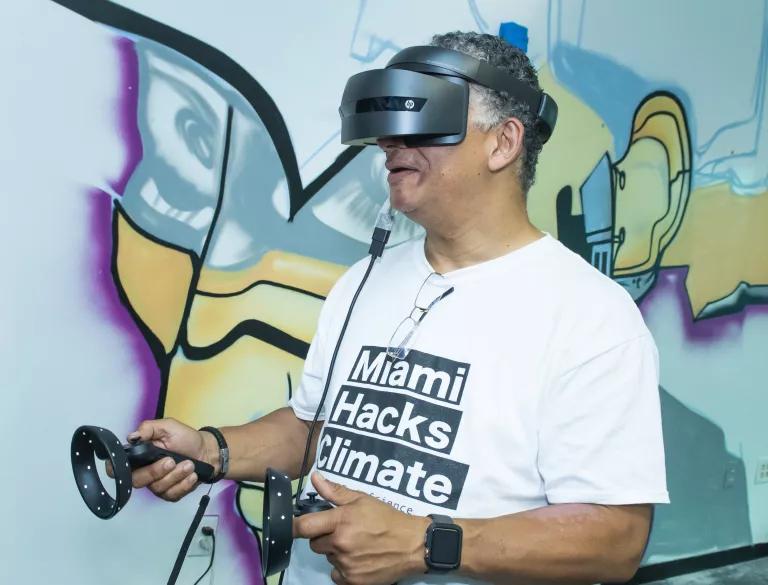Street Art and Augmented Reality Get Real About Climate in Miami
An AR-enabled mural by Muta Vision and Odobo, part of a climate-focused mural series called Miami Murals, shows two alternate futures for the city
But one mural, across the street from the historic City of Miami Cemetery, stands out for its ingenious integration of technology and environmental activism. The image is instantly recognizable as a play on a classic postcard that spells out Miami in big, bold letters, but there’s a sly twist.
The first letter is an M blinged out with diamonds like a flashy wristwatch might be. The last letter is a Xanax capsule standing on its end to form an I. It symbolizes the city’s booming party culture, says Linda Cheung, founder of the Before It’s Too Late environmental advocacy group, which erected the mural earlier this year. But the work also speaks, she says, to the numbness that so many people feel in the face of the looming effects of climate change.

The artistic experience really starts, though, when you plug into the group’s free augmented reality (AR) app, which activates the cameras of Apple and Android smartphones. In crisp 3D detail, ocean waves suddenly lap at the feet of the letters, and a charming little yellow canary warns viewers about the ominous changes on the way.
The fun isn’t over yet. You can choose between future scenarios such as “Make No Change,” which conjures a dystopian vision of crumbling buildings and rising sea levels, or “Be the Change,” where power-generating wind turbines spin in the distance and fish and manatees swim in a clean ocean.
Viewers end up in a strange dance in front of the mural, their heads bobbing and turning to take in the animated scene from every possible perspective. “It’s a totally new angle,” says Cheung, a recent graduate of MIT’s Sloan School of Management, where she first became interested in the merging of art and technology for social justice campaigns.

“Part of the strategy here is to use something like augmented reality that intrigues people, to get them interested in a campaign about climate change that they wouldn’t ordinarily be interested in,” she says. “I want to make climate change sexy.”
The mural/app combo was made by a team of painters, AR and 3D programmers, and musicians, with Cheung acting as conceptualist and curator. Since it was unveiled last February, the Miami Murals project has added 20 paintings to the walls of the EcoTech Visions technology incubator in Miami. They include pieces by Eric Karbeling and Cuban-born Reinier Gamboa.

Cheung is now working with community groups throughout the city to commission other climate change–related works of art, such as physical installations. “It’s not just murals anymore,” says Cheung. One artist, for instance, creates art out of recycled plastic bags, and another created a hurricane out of denim.

Also on the horizon is an effort to make a game that meshes art with climate concerns during this year’s Art Basel Miami Beach art fair in December. “There will be challenges, like little Easter eggs placed around the murals on the beach that you can open up with an app,” Cheung explains of the project, which is still in the planning phase. “We’ll challenge you to make a commitment to change your personal behavior, like stop using plastic straws, or pledge to turn out and vote for a carbon tax, or show up at a commissioners’ meeting.” Viewers can then use the app “to see how the movement grows and progresses.”
“We want to inspire a million actions,” says Cheung.
This article was originally published on onEarth, which is no longer in publication. onEarth was founded in 1979 as the Amicus Journal, an independent magazine of thought and opinion on the environment. All opinions expressed are those of the authors and do not necessarily reflect the policies or positions of NRDC. This article is available for online republication by news media outlets or nonprofits under these conditions: The writer(s) must be credited with a byline; you must note prominently that the article was originally published by NRDC.org and link to the original; the article cannot be edited (beyond simple things such grammar); you can’t resell the article in any form or grant republishing rights to other outlets; you can’t republish our material wholesale or automatically—you need to select articles individually; you can’t republish the photos or graphics on our site without specific permission; you should drop us a note to let us know when you’ve used one of our articles.
Comments
Post a Comment